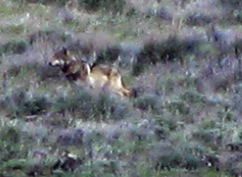I am pleased to announce our first Wild Animal of the Year, recognizing contribution to the welfare of wildlife. The winner is OR-7, the wandering wolf, also known as Journey.
OR-7 bears his name because, as a recent Associated Press story recounts, “he was the seventh wolf in Oregon to be fitted with a GPS tracking collar.” OR-7 left his pack in northeast Oregon in September of 2011, traveling to the Cascade Mountains near Crater Lake National Park, in the southwest part of the state.
The following month, conservation group Oregon Wild sponsored a naming and art contest for the wolf. This garnered international publicity, and helped make OR-7 too famous to be killed. OR-7 traveled to northern California the next month, December.
In January 2012, Oregon Wild announced the outcome of its contest. The winning name was, appropriately, “Journey.” The winning art “came from an 8-year-old Portland girl … whose depiction of wolves howling into a moonlight night captured the spirit of OR-7 and his search for a mate.”
OR-7 is presumed to be looking for a mate or a new pack. However, he is currently the only wolf in California, and the first since 1924. The California Department of Fish and Wildlife tracks the wolf, and has mapped his travel within California through July 2012. He has now traveled more than 2,000 miles since arriving in the state.
Achievements
We honor OR-7 for his being a pioneer in the return of wolves to California, and his having helped the cause, nationally and internationally, of wolf preservation and restoration. Consider what he has achieved to date:
- He has caught the attention of the media in the U.S. and overseas.
- He sparked the creation of a Facebook group, OR-7 Wandering Wolf of America, that follows the news concerning him and supports the welfare of wolves around the world. (I serve as an administrator for this group.)
- He has generated interest from conservation organizations, including those that focus on wolves. Among the latter are the Wolf Conservation Center, in South Salem, New York; the International Wolf Center, in Ely, Minnesota, and the California Wolf Center in Julian, California.
- He led environmental groups to petition successfully the California Fish and Game Commission. It is conducting a status review to consider listing wolves as an endangered species under state law. (Meanwhile, federal law protects wolves in the state.)
- He inspired a documentary, OR7 – The Journey, now in production.
- Finally, he stimulated the creation of the Pacific Wolf Coalition last month, on the anniversary of his entering California: “Twenty-five wildlife conservation, education and protection organizations in California, Oregon and Washington … announced the formation of an alliance committed to recovering wolves across the region. The … Coalition envisions populations of wolves restored across their historic habitats in numbers that will allow them to re-establish their critical role in nature and ensure their long-term survival.”
OR-7 has helped people become more aware of wolves, their ecological importance, the myths concerning them, threats to their survival, and the opportunity for repopulation.
The Threat to Wolves
The normal tendency of government is to favor special interests, and this has been true with respect to wolves. In the U.S., government kills wolves, or allows their decimation through hunting, in order to satisfy the ranching industry and some sportsmen’s groups. See, e.g., this article and this study. However, as discussed in the study, wolves are beneficial to the health of elk and other game animals, and ranchers can use non-lethal means of protecting livestock.
Last summer, Jamie Rappaport of Defenders of Wildlife addressed the plans of Idaho, Montana, and Wyoming after the loss of federal protection of wolves in these states:
No other native species is managed to a biological minimum. Reducing the population to such low levels defeats the purpose of restoring wolves in the first place–allowing them to fulfill their important ecological role in maintaining nature’s balance. The goal should be to help the wolf population continue to recover, not put it right back on life support.
Human fear also threatens wolves, and politicians sometimes encourage this fear. The reality is that wolves fear humans, and present little danger. As the International Wolf Center notes, “A person in wolf country has a greater chance of being killed by a dog, lightning, a bee sting or car collision with a deer than being injured by a wolf.”
Dr. Reese Halter has observed,
[Wolves] have suffered from an unnecessary war that we have waged against them for centuries, and somehow managed to survive. Wolves are a symbol of courage, endurance, and admirable intelligence.
Conclusion
Instead of persecution, wolves deserve our interest and compassion. As Hélène Grimaud, founder of the Wolf Conservation Center, explained,
The main challenges facing the wolf are always human misunderstanding and ignorance. There is no hope of conservation without education.
OR-7 has helped more people understand and appreciate wolves. He has served as a symbol of wolves everywhere, and an inspiration for continued efforts on their behalf.
[Links updated: November 30, 2015]





